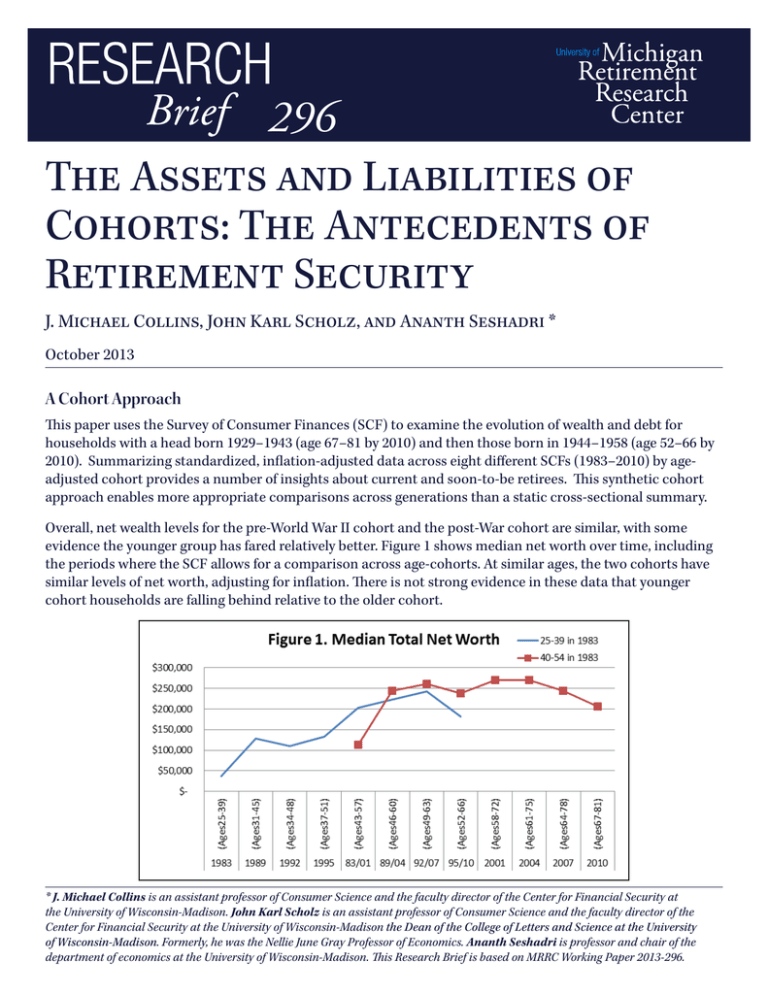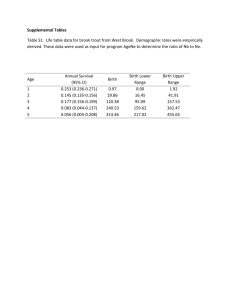The Assets and Liabilities of Cohorts: The Antecedents of Retirement Security
advertisement

296 The Assets and Liabilities of Cohorts: The Antecedents of Retirement Security J. Michael Collins, John Karl Scholz, and Ananth Seshadri * October 2013 A Cohort Approach This paper uses the Survey of Consumer Finances (SCF) to examine the evolution of wealth and debt for households with a head born 1929–1943 (age 67–81 by 2010) and then those born in 1944–1958 (age 52–66 by 2010). Summarizing standardized, inflation-adjusted data across eight different SCFs (1983–2010) by ageadjusted cohort provides a number of insights about current and soon-to-be retirees. This synthetic cohort approach enables more appropriate comparisons across generations than a static cross-sectional summary. Overall, net wealth levels for the pre-World War II cohort and the post-War cohort are similar, with some evidence the younger group has fared relatively better. Figure 1 shows median net worth over time, including the periods where the SCF allows for a comparison across age-cohorts. At similar ages, the two cohorts have similar levels of net worth, adjusting for inflation. There is not strong evidence in these data that younger cohort households are falling behind relative to the older cohort. * J. Michael Collins is an assistant professor of Consumer Science and the faculty director of the Center for Financial Security at the University of Wisconsin-Madison. John Karl Scholz is an assistant professor of Consumer Science and the faculty director of the Center for Financial Security at the University of Wisconsin-Madison the Dean of the College of Letters and Science at the University of Wisconsin-Madison. Formerly, he was the Nellie June Gray Professor of Economics. Ananth Seshadri is professor and chair of the department of economics at the University of Wisconsin-Madison. This Research Brief is based on MRRC Working Paper 2013-296. Expanding Use of Debt There is a striking increase in mean and median total debt, however, as shown in Figure 2. Younger cohorts are borrowing more than the prior generation, relative to total assets and to income, although debt-holding declines with age. Debt is mainly driven by households taking on larger mortgages. In 2010 households with a head ages 52–66 had a mean of $399,935 in financial assets and $78,098 in mortgage debt. In 1995, households with a head ages 52–66 had $336,477 in financial assets and $52,046 in mortgage debt. Examining medians, the younger group had $43,210 in median financial assets and $10,300 in mortgage debt, while the older cohort at the same ages in 1995 had $51,676 in median financial assets and $0 in mortgage debt. The increase use of debt is perhaps a necessary tactic used by the young cohort to keep up with the older cohort. This may result in greater default risk exposure for the younger cohort; arguably these measures do not account for the larger expected variance in asset and net wealth that might be associated with this additional risk-taking. Overall net worth does not show evidence of increased losses due to defaults, however. It is clear that housing and mortgages are an increasingly important factor to monitor. How well successive cohorts will fare is worth carefully monitoring, especially in light of the aftermath of the 2008 recession. The use of home equity conversion mortgages (reverse mortgages) seems likely to increase as more households, especially those without college education and minorities, enter retirement with few financial assets. Differences by Education Level Net worth for households with some college education is much larger for each age-adjusted cohort. For example, the 46–60 age cohort in 2004 shows about $109,500 in median net worth for households with a high school education or less, compared to almost $369,000 for those with some college (4.4 times as much). For the same age cohort in 1989, the median among the some-college group was 2.6 times the median of the high school or less education group. Figure 3 shows financial assets by education level with households where the head has at least some college having greater levels of debt across both cohorts. Overall, college education appears to be a strong factor related to net worth, assets and debt. Increasing rates of college education for successive cohorts ought to result in rising financial assets and net worth through increased earnings, but will also (almost by definition) result in rising median debt holding by households across the distribution. 2 Differences by Race Financial assets are especially low for minorities, as shown in Figure 4. A 52–66 year old in 2010 from the younger cohort had financial assets of $68,000 and non-financial assets (mainly a home) of $224,000, meaning that financial assets were 23% of total assets. For minorities in the same year and age cohort, financial assets were a scant $7,310 and non-financial assets $105,700, meaning financial assets were just 6% of total assets. These ratios are relatively similar for the older cohort. Even without major shifts over time this is consistent with minority households mainly having non-financial wealth, primarily in their homes, which experienced significant volatility in the last decade. Overall This paper presents a series of stylized facts that are consistent with growing debt levels for more recent cohorts of households, but not lowered net worth. Much of this rise in debt levels is related to mortgages, which account for the majority of debt. There is evidence of a minimal trend toward concentrated wealth 3 where a small number of households are gaining wealth at slightly faster rates. We do not see strong evidence of the baby boom cohort struggling to keep up in terms of net wealth, nor is this recent age cohort suffering undue exposure to default risks related to higher levels of borrowing. The picture for minority households stands in stark contrast to that of non-minorities. Minorities have few financial assets and their wealth is concentrated in non-financial assets such as housing. These households also experienced steep declines in financial assets and net worth during the recession. University of Michigan Retirement Research Center Institute for Social Research 426 Thompson Street Room 3026 Ann Arbor, MI 48104-2321 Phone: (734) 615-0422 Fax: (734) 615-2180 mrrcumich@umich.edu www.mrrc.isr.umich.edu Sponsor Information. The research reported herein was performed pursuant to a grant from the U.S. Social Security Administration (SSA) through the Michigan Retirement Research Center (MRRC). The findings and conclusions expressed are solely those of the author(s) and do not represent the views of SSA, any agency of the federal government, or the MRRC. Regents of the University of Michigan: Mark J. Bernstein, Ann Arbor; Julia Donovan Darlow, Ann Arbor; Laurence B. Deitch, Bloomfield Hills; Shauna Ryder Diggs, Grosse Pointe; Denise Ilitch, Bingham Farms; Andrea Fischer Newman, Ann Arbor; Andrew C. Richner, Grosse Pointe Park ; Katherine E. White, Ann Arbor; Mary Sue Coleman, Ex Officio 4




